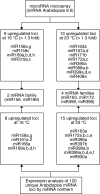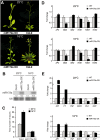Genetic framework for flowering-time regulation by ambient temperature-responsive miRNAs in Arabidopsis
- PMID: 20110261
- PMCID: PMC2875011
- DOI: 10.1093/nar/gkp1240
Genetic framework for flowering-time regulation by ambient temperature-responsive miRNAs in Arabidopsis
Abstract
Flowering is the primary trait affected by ambient temperature changes. Plant microRNAs (miRNAs) are small non-coding RNAs playing an important regulatory role in plant development. In this study, to elucidate the mechanism of flowering-time regulation by small RNAs, we identified six ambient temperature-responsive miRNAs (miR156, miR163, miR169, miR172, miR398 and miR399) in Arabidopsis via miRNA microarray and northern hybridization analyses. We also determined the expression profile of 120 unique miRNA loci in response to ambient temperature changes by miRNA northern hybridization analysis. The expression of the ambient temperature-responsive miRNAs and their target genes was largely anticorrelated at two different temperatures (16 and 23 degrees C). Interestingly, a lesion in short vegetative phase (SVP), a key regulator within the thermosensory pathway, caused alteration in the expression of miR172 and a subset of its target genes, providing a link between a thermosensory pathway gene and miR172. The miR172-overexpressing plants showed a temperature-independent early flowering phenotype, suggesting that modulation of miR172 expression leads to temperature insensitivity. Taken together, our results suggest a genetic framework for flowering-time regulation by ambient temperature-responsive miRNAs under non-stress temperature conditions.
Figures





References
-
- Carrington JC, Ambros V. Role of microRNAs in plant and animal development. Science. 2003;301:336–338. - PubMed
-
- Schauer SE, Jacobsen SE, Meinke DW, Ray A. DICER-LIKE1: blind men and elephants in Arabidopsis development. Trends Plant Sci. 2002;7:487–491. - PubMed
-
- Rhoades MW, Reinhart BJ, Lim LP, Burge CB, Bartel B, Bartel DP. Prediction of plant microRNA targets. Cell. 2002;110:513–520. - PubMed
-
- Palatnik JF, Allen E, Wu X, Schommer C, Schwab R, Carrington JC, Weigel D. Control of leaf morphogenesis by microRNAs. Nature. 2003;425:257–263. - PubMed
Publication types
MeSH terms
Substances
LinkOut - more resources
Full Text Sources
Molecular Biology Databases

